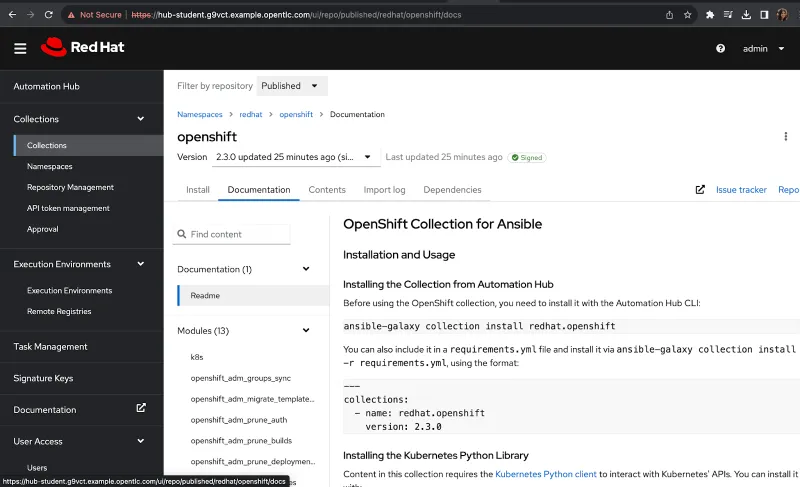
OpenShift meets Ansible
We have seen many organizations compare themselves on how agile they are in the innovation journeys. When we talk about innovation, there are several aspects around it, like optimizing the existing IT, integrating apps/data/processes, adding and managing cloud infrastructure or modernizing the applications. But in order to partner with lines of business to better compete, there is a need to introduce automation.
If someone asks, “What can we automate?” Below is my answer:
"Every non-interruptive CLI command or any UI which exposes a REST-API is an opportunity to automate."
Whether it be orchestrating configurations, deploying applications or managing infrastructure, etc.
Red Hat Ansible Automation Platform does all that!
Whether managing cloud or cloud-native systems, there is no difference. In this article, I’ll go through integrating an OpenShift cluster with Ansible Automation Platform to help automating Day 0 and Day 2 activities.
Tying OpenShift with Ansible Automation Platform
When it comes to container orchestration, Red Hat OpenShift has emerged as the leading enterprise level solution, providing a robust platform to manage and scale complex applications with ease. However, manual deployment and management of these applications can be labor intensive and prone to issues.
Enter Ansible Automation Platform: Its strength lies in its simplicity, scalability and ability to bridge the gap between complex IT tasks and efficient execution by turning manual, repetitive tasks into automated workflows. One of its standout components is Red Hat Ansible Certified Content Collections - pre-packed automation content that encompasses modules, plugins, and roles to simplify automation. Among these, the redhat.openshift.k8s collection paves the way for Red Hat OpenShift automation by bringing ease and efficiency of Ansible into your Red Hat OpenShift environments, streamlining your processes.

Red Hat Ansible Certified Content Collections in Ansible automation hub
We have worked with many Banking, Financial Services and Insurance (BFSI) accounts at Red Hat, and we would like to share one of the lessons learned on how Ansible naturally fits into the OpenShift environment.We’ll show how the redhat.openshift.k8s collection can not only reduce manual efforts of deployment, but also enables consistency across deployments,efficiency and fewer errors when deploying applications within an OpenShift cluster.
Let us start simple
To start simple, Red Hat OpenShift and Ansible use similar patterns and YAML scripts to describe the desired state of the world:
| OPENSHIFT/OC | ANSIBLE |
apiVersion: v1
| - name: Create foo config map
|
On the left is an OpenShift definition to define any resource. On the right is an Ansible definition to define any OpenShift resource. Notice the similarities?With Ansible, additional features are available so you can maintain the entire definition as a separate Jinja2 template file as in the below example:
| - name: Create foo config map redhat.openshift.k8s: template: foo.yml |
Templatising Openshift Definition
Red Hat OpenShift and Ansible are better together, and one real world example of this is automating the deployment of the Redis leader/follower application on an OpenShift cluster. This scenario takes advantage of the following Ansible Playbook provided in this repository.
Let us automate!
The solution automates the following:
- Creation of guestbook namespace, where I’ll be carrying out the deployment using the Red Hat Certified Collection
- Deploying Redis leader, Redis follower and the front end application
- Configuring networking objects such as services and routes
As a preliminary step, I have downloaded the Red Hat Certified Collection for OpenShift in private automation hub as shown below:

Openshift Collection in Private Automation Hub
I’ll configure the below resources on Ansible Automation Platform to get started:
- Project to import the Git source code
Project Name: Openshift
Source Control Type: Git
Source Control URL: https://github.com/RachnaDodia/k8_ansible.git
Organization: Default <or as per your environment> - Credentials to store OpenShift API URL and the token for authentication
Credential Name: OpenShift
OpenShift or Kubernetes API Endpoint: <as per your environment>
API authentication bearer token: <as per your environment>
Organization: Default <or as per your environment> - Credentials to store private automation hub URL and token for authentication
Credential Type: Ansible Galaxy/Ansible automation hub API Token
Galaxy Server URL: <as per your environment>
API Token: <as per your environment>
Organization: Default <or as per your environment> - Template using the resources created above
Template Name: Deploy Redis Leader-Follower Application
Project: OpenShift
Playbook: deploy.yml
Credentials: OpenShift
Execution Environment: Default execution environment
Organization: Default <or as per your environment>
Once the template is configured , let’s get ready to launch! Here is the output of creating the resources with Ansible Automation Platform:

Ansible UI output of successful playbook execution
With successful execution of the automation job, let us go to the OpenShift environment to verify the changes:

Deployments in guestbook Namespace

Route mapping to the Service

Front end application
Success! We have deployed the application and created the necessary networking resources.
Takeaways
Thanks to the Red Hat Certified Collection for OpenShift, automating OpenShift is significantly easier. You have seen now how effortlessly multiple configurations can be performed on an OpenShift cluster. Not only can you begin with Day 0 operations, but you can manage Day 1 and Day 2 operations as well. This can be improved upon by maintaining all the Configuration as Code (CaC), where you would separate configuration settings from the actual code. Ideally, you can store that configuration data in source control such as Git, and easily run and tweak it to match different environments.
A key piece of advice: Don’t limit yourself as an OpenShift admin, but take it to the next level with automation.
Where to go next
- Get hands-on with on-demand Ansible Automation Platform self-paced exercises - We have a variety of interactive in-browser exercises to experience Ansible Automation Platform in action.
- Trial subscription - Are you ready to install on-premises? Get your own trial subscription for unlimited access to all the components of Ansible Automation Platform.
- Red Hat Developer subscription - Did you know you can get a free Red Hat Developer subscription to learn in your home lab. Register and get access to all the latest tools and technologies that Red Hat offers.
- Subscribe to the Red Hat Ansible Automation Platform YouTube channel
- Follow Red Hat Ansible Twitter - Do you have questions or an automation project you want to show off? Tweet at us!
Sobre el autor
Más como éste
Friday Five — January 9, 2026 | Red Hat
Accelerating success with the Red Hat Partner Program
Technically Speaking | Build a production-ready AI toolbox
AI Is Changing The Threat Landscape | Compiler
Navegar por canal
Automatización
Las últimas novedades en la automatización de la TI para los equipos, la tecnología y los entornos
Inteligencia artificial
Descubra las actualizaciones en las plataformas que permiten a los clientes ejecutar cargas de trabajo de inteligecia artificial en cualquier lugar
Nube híbrida abierta
Vea como construimos un futuro flexible con la nube híbrida
Seguridad
Vea las últimas novedades sobre cómo reducimos los riesgos en entornos y tecnologías
Edge computing
Conozca las actualizaciones en las plataformas que simplifican las operaciones en el edge
Infraestructura
Vea las últimas novedades sobre la plataforma Linux empresarial líder en el mundo
Aplicaciones
Conozca nuestras soluciones para abordar los desafíos más complejos de las aplicaciones
Virtualización
El futuro de la virtualización empresarial para tus cargas de trabajo locales o en la nube
